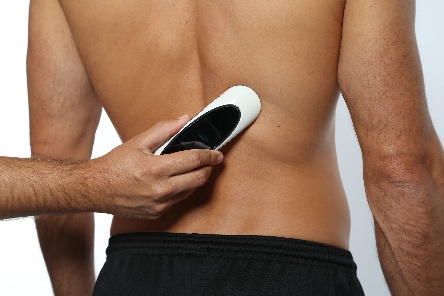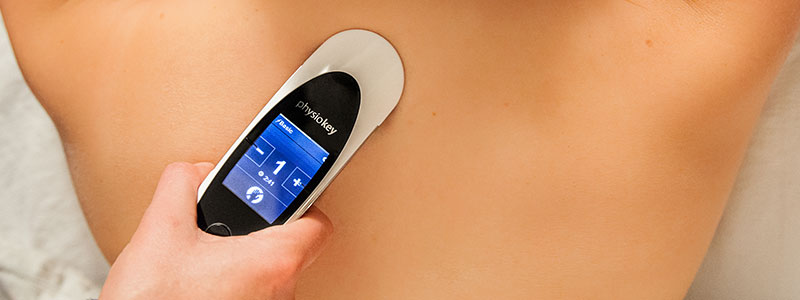|
➔ PHYSIOKEY in Cambridge
 What is it Physiokey? What is it Physiokey?
The Physiokey is a
feedback controlled non-invasive neurostimulator for the treatment of acute
and chronic pain. It
is a comforting, pain relief, fast treatment, thanks to the latest
developments in neurostimulation technology.
What can it do to your
body?
This therapeutic, natural method of pain relief is an effective
alternative to drug-based therapies and medicines. It helps pain relief of
most common problems like knee/back pains, sciatica, sport injuries,
arthritis, neck/shoulder pain, fibromyalgia, sinus, migraines, etc. The
best part is that it works without causing addiction, overdose or unwelcome
side effects.
How does it work?
The main function of the
Physiokey is to get rid of pain and allow you to get back to your daily
routine. It activates your bodies defences, by directing high-amplitude,
bio-feedback controlled pulses to your cutaneous nerves. This encourages your
body to do what it should do when you feel unwell and release tremendous
tension.
Physiokey is a non-invasive treatment, which restores the body’s self-healing mechanism.
The Physiokey device emits an electro-magnetic signal, which is almost identical to the human nerve signal. This signal travels along certain types of nerve fibres and meridians, which triggers the release of powerful pain relieving substances into the bloodstream called endorphins. Physiokey also stimulates the production of neuropeptides, which rapidly advances healing.
Does
it really work?
Hear other people's real stories:
Who can benefit from Physiokey?
Anyone who is experiencing pain whether chronic or acute may benefit from Physiokey therapy. Pain can be useful! When you have an injury, pain alerts the brain and the body to where the injury is so that the brain can produce its pain-killing endorphins and the body can begin to heal.
Imagine a sprained ankle, the pain alerts the nervous system and the body responds immediately so that the injury can begin to heal as soon as possible. After all the body cannot afford for you to limp around for very long! This is an acute injury and the pain is a positive symptom of healing. On the other hand, often pain persists long after a reasonable healing period has elapsed, especially if the damage was severe or extensive. Extended use of pain killers can also affect healing because they take away the signal the brain needs to repair the injury. After a while the brain, nervous system, endocrine and immune system cannot work on the injury any longer but the pain is still there, this is called chronic pain. Physiokey helps our adaptation systems produce mediators, hormones and other chemical substances and redirects the body’s energy back to the injury and gives the body what is known as “PRIMARY FOCUS”, the body can then begin to repair itself.
How does Physiokey differ from other treatments?
The difference between Physiokey and some other therapies, which may require you to have indefinite on going treatment, is that Physiokey takes the body through the healing cycle to completion. This means that once your treatment is finished, it is unlikely that you will need further treatment for the same problem. Most acute problems only require 4 to 6 sessions.

What happens during the first Physiokey session?
During your first session you will be asked to complete a full medical history. It is important that you complete this as fully and honestly as possible, taking particular care to detail any medication you may be taking. This information is essential for the therapist to formulate an accurate treatment plan. You will be asked to remove clothing appropriate to where your injury is and towelling robes are provided for your modesty and comfort. When the Physiokey is applied to the skin you will feel a pins and needles sensation, you will be asked what energy level is comfortable for you. Please remember it is not an endurance test!
Your treatment will be devised according to the information you give to the therapist and may consist of localised, general or a combination of both treatments. Using the Physiokey to treat local symptoms (e.g. when there is only one point of pain) is like a lighthouse flashing its beacon to make ships aware of its location. When the Physiokey device is used at the point of pain it then becomes the lighthouse sending out huge bright beams of light across the waves to show ships or in this case the brain where to focus it’s attention. It is saying loud and clear “here I am!”
When there is more than one area of pain or lots of different complaints, then the brain doesn’t always know where to start its work. By treating generally you are helping the brain and the body to assess the order in which it needs to heal. It is rather like de-fragmenting your computer! Another example is to imagine a filing cabinet full of files. Now imagine turning it upside down and emptying all the files on to the floor in one big heap. Everything is all mixed up and now you have to sift through the whole lot and begin to put them all back in the right order. Whilst you are sifting through the files you see that there are some files, which are incomplete, so you put them to one side so that you can complete the work before it is filed away again. This in effect is what happens when you work generally with the Physiokey. Any unfinished business is put to one side and is dealt with in order of priority. This is why newer symptoms usually disappear first and older problems take longer to disappear.
What should I expect during or after treatment?
During treatment it is normal to experience some, all or none of the following reactions:
- Light headedness
- Skin reactions (e.g. redness, itching, sensitivity)
- Tiredness
- Feeling cold
- Feeling thirsty
- Pain moving or shifting
After treatment and during your prescribed course of treatments you may still experience some of the above reactions and may also experience the following. - Flu like symptoms or nausea
- Increased pain, this can sometimes be stronger pain than before the treatment. This is a positive indication that the treatment is working and should gradually subside. It is a normal reaction and should not cause alarm. To alleviate symptoms a hot water bottle may be applied to the painful area. It is preferable not to take painkillers however they may be taken if pain is very strong.
- Improved sleeping patterns although sleep may be disrupted for the first few days as the brain sorts out its internal “filing system”.
- Area of pain becoming more localised as the body heals.
- Increased range of movement.
- Improved mood and sense of well-being.
- Increased energy levels.
Please tell your therapist if you experience any of the above reactions either during or following your treatment, as this feedback is useful to help plan treatment sessions. You may wish to make notes on changes occurring between treatment sessions and these are also useful to the therapist.
What to do during a course of Physiokey treatment.
It is extremely important to drink plenty of water, to help the body flush out toxins and to repair. Your body cannot effectively heal itself if it is dehydrated. Rest is important, your body repairs primarily when you sleep so rest is crucial for recovery. Exercise should be avoided for the first week or two; you can discuss this further with your therapist. Eat well; remember your body needs good nutrition to repair itself!
Why do my sessions need to be so close together?
When treating with the Physiokey device it is very important to treat frequently and for long enough to ensure that the condition is fully resolved. It is like pushing a rusty wheel up a steep hill. Once you get to the top, the wheel will go along on its own, but if you get half way up and then stop, it will roll right back down to the bottom and you are back to where you started! It is the same with Physiokey. You have to give the body and the brain enough information and momentum to be able to do the work itself, once it knows what to do, it will continue on its own, but stop too soon and it will simply return to how it was before you started. A typical course of treatment would require you to have three sessions within one week; if further treatments were necessary they would then be weekly.
What not to do during a course of Physiokey treatment.
Don’t over exercise! Remember your body is healing and you may begin to use muscles that you haven’t used for a while or have been compensating by using other muscle groups. If necessary, you will be referred to a sports and remedial therapist for a rehab and exercise programme.
What to expect once you have finished treatment:
Physiokey continues to work even after you have completed your course of treatment so don’t be concerned if you are discharged before you are completely better. Most people continue to improve for approximately three months after treatment and some continue to improve for up to five months. It is also common to experience flare ups of old symptoms and pain during this period as the body continues to heal and this is completely normal. You should contact your therapist if you are concerned or if the symptoms last more than a few days or are severe. Contact your therapist if you experience any new or unusual symptoms.
And finally, please remember!
Your body takes time to heal! Your symptoms didn’t just suddenly appear, they took time and recovery takes time and patience too! Please focus on the positive effects of the treatment. CHANGE is what is important, as long as your symptoms are changing (this means they may feel better OR worse) then the treatment is working.

|

 What is it Physiokey?
What is it Physiokey?
